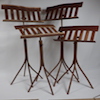I've build numerous table tops and always struggled trying to achieve a nice looking radius on the outside corners. I finally broke down and purchased a jig thinking this would solve my problems.
Router jig.jpg
I used the supplied screws and fastened the jig to the underside of the workpiece. All 4 corners ended up with less than perfect radii and required sanding to make the corner - edge transition smooth.
Has anyone used one of these jigs before. It seemed like the perfect solution but left a bit to be desired. What am I doing wrong?




 Reply With Quote
Reply With Quote






